Yoho National Park – We Are Blown Away
Along with Glacier, Yoho is the second oldest of Canada’s wonderful national parks and on a recent visit with my two sons, grandson and later with Alison, I discovered why this must be rated as an absolute must visit park. While we barely scratched the surface of things to do in Yoho, what we did see and do was immensely satisfying and made us all proud that Parks Canada is preserving this treasured place for future generations. Won’t you join us on a whirlwind tour?
Yoho was the third of four national parks in the mountainous interior of British Columbia that we visited on a recent RV trip. Here are links to posts on Mount Revelstoke and Glacier National Parks. Initially I was travelling with my oldest son Alex and his son A.J., but in Yoho we were joined by youngest son Dale. Later in the week, after the boys departed, I returned to Yoho with Alison as we hiked into Wapta Falls which I will describe at the end of this post..
The four of us started the day at the Illecillewaet campground in Glacier National Park and headed east on the Trans-Canada Highway with Kicking Horse campground in Yoho as our destination. After passing through the mountain town of Golden we navigated what is really a treacherous stretch of the TCH (which is currently being upgraded thank goodness) and entered through Yoho’s western entrance.
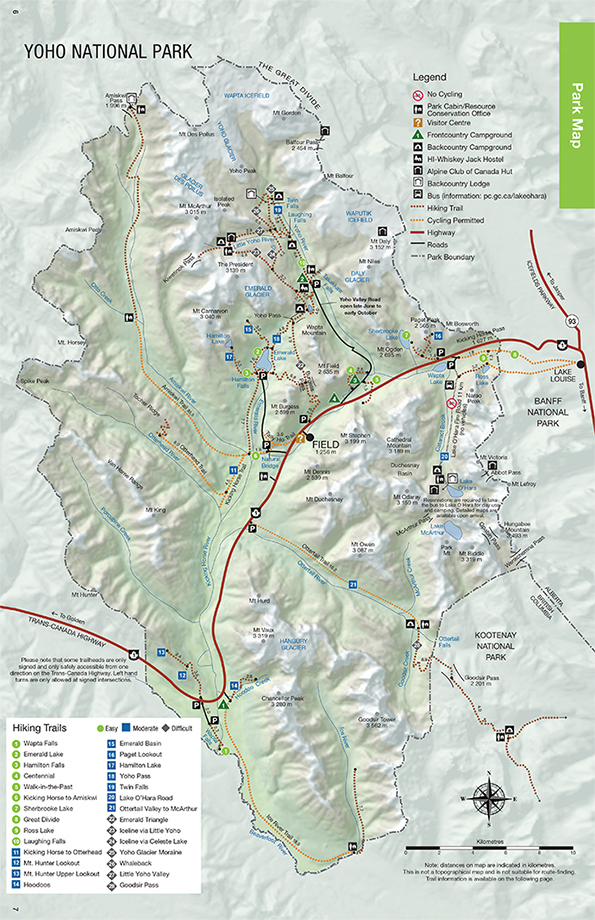
According to the Parks Canada website the name Yoho is a Cree expression of awe and wonder, something like today’s “Holy s***!” The centrepiece of the park is the Kicking Horse River, a designated Canadian Heritage River and its various tributaries, most notably the Yoho, that have created a number of valleys amidst twenty-eight peaks that top out at over 3,000 metres (9,800 feet). Not surprisingly whitewater rafting and mountain climbing are both big draws at Yoho.
Our original plan was to hike into Wapta Falls, the trailhead of which is not too far from the western entrance. However, the weather is totally uncooperative and it is simply pouring so we opt to give Wapta Falls a pass today. However, like General MacArthur, I shall return.
Field – Yoho’s Magic Little Town
The only permanent settlement inside Yoho is the tiny town of Field, which has only 200 residents and yet is one of the most popular towns in the Canadian Rockies. Originally built as a base for railway workers it evolved into a railway town providing good union jobs that allowed the CPR workers to build sturdy homes able to withstand the onslaught of winter in the Rockies. Today the trains no longer need to take on water or fuel at Field and simply pass by, the abandoned water tower a testament to bygone days. However, the railway workers have been replaced by artisans and adventure seekers drawn to the natural beauty of the location on the Kicking Horse River. It seemed that every second house in Field was now a B&B and virtually every one had a no vacancy sign.
After visiting the very modern visitors centre, we parked the RV and drove into the town in Dale’s car to have a look around and get some lunch. There were several choices, but Truffle Pigs seemed to be the busiest with the most interesting menu and we opted to wait the twenty minutes it took to get one of the few tables in the bistro.
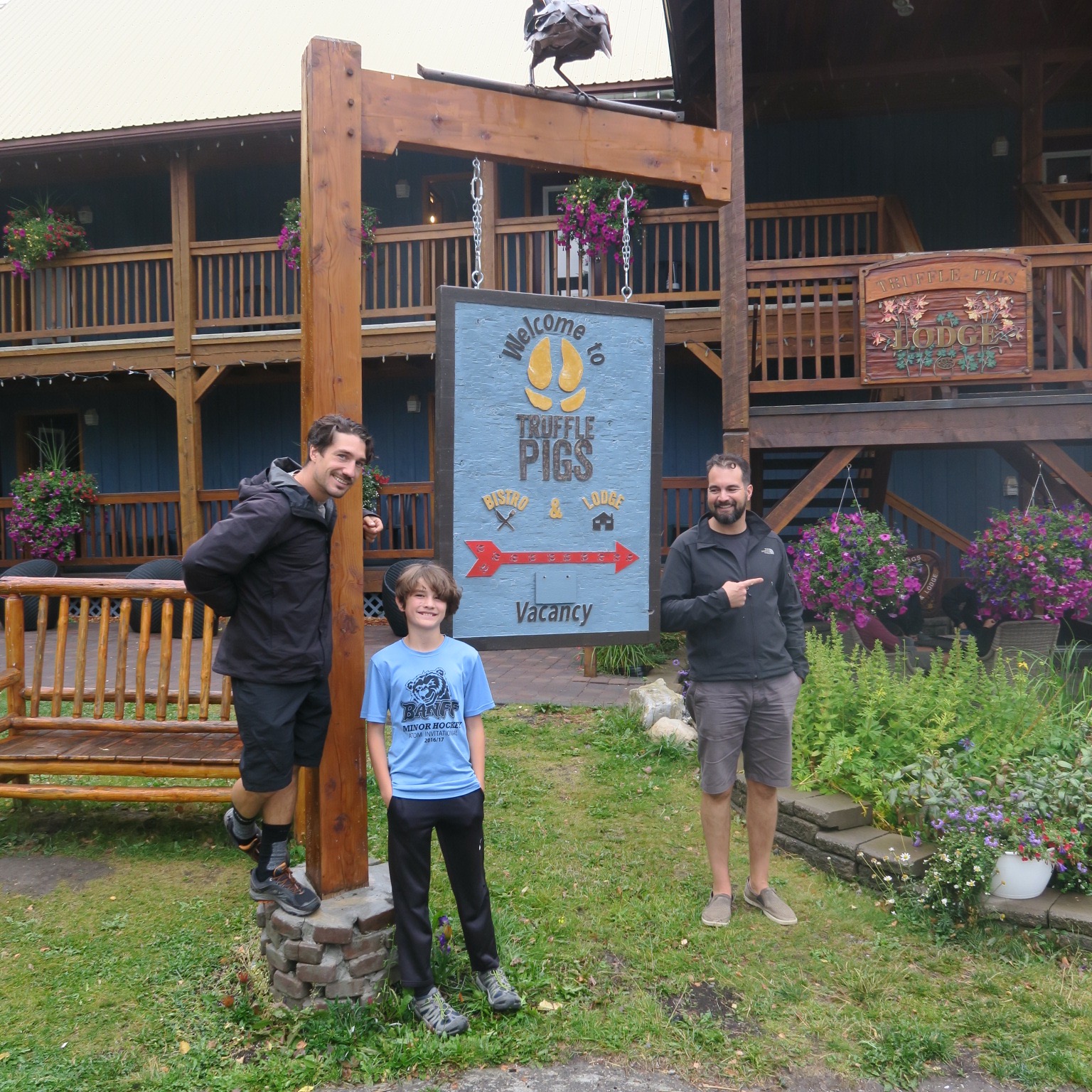
The wait was well worth it, both for the funky interior where pigs do fly,
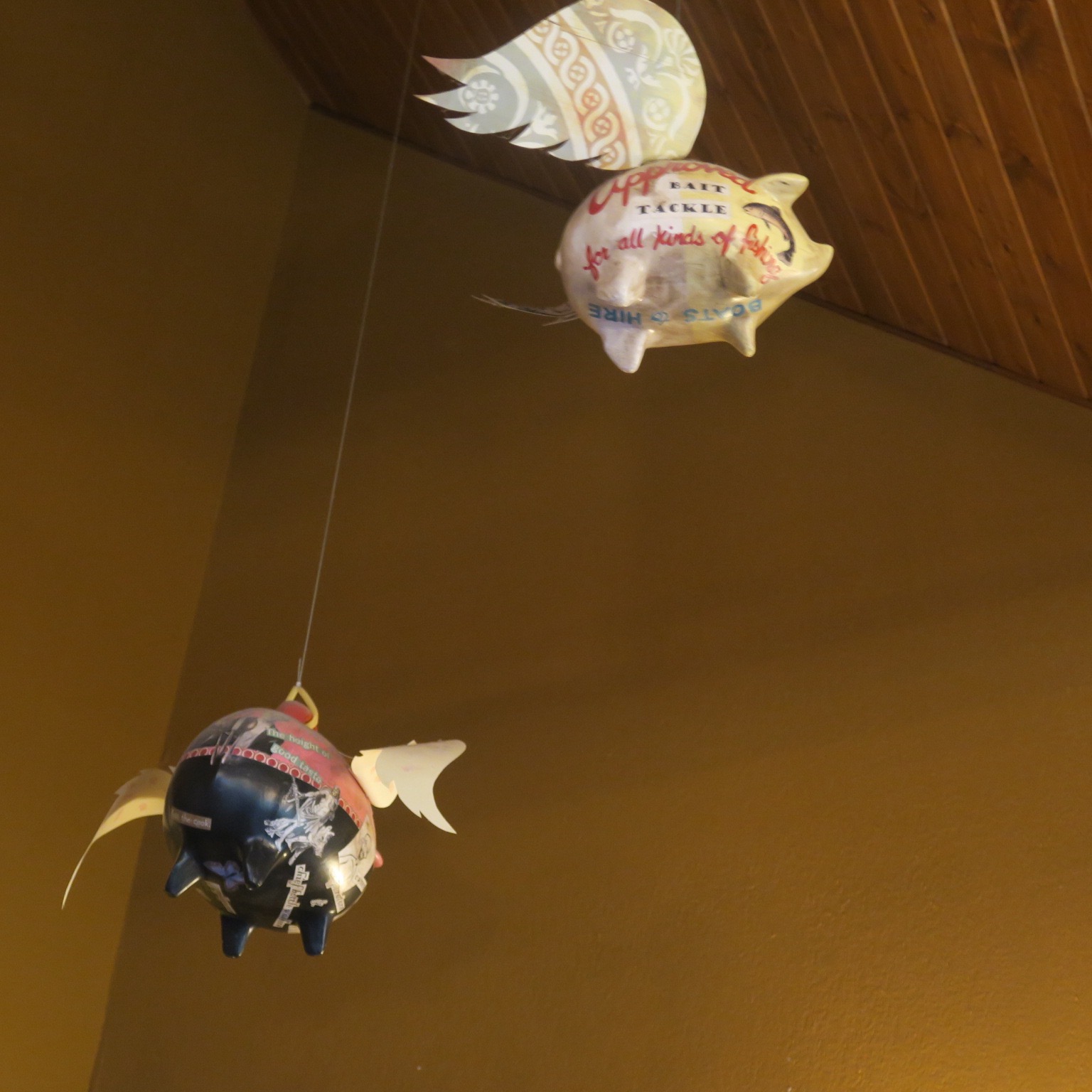
and for the excellent food and drink. There were a number of craft beers available including this delicious (according to Dale & Alex – I was driving the RV) ginger beer.
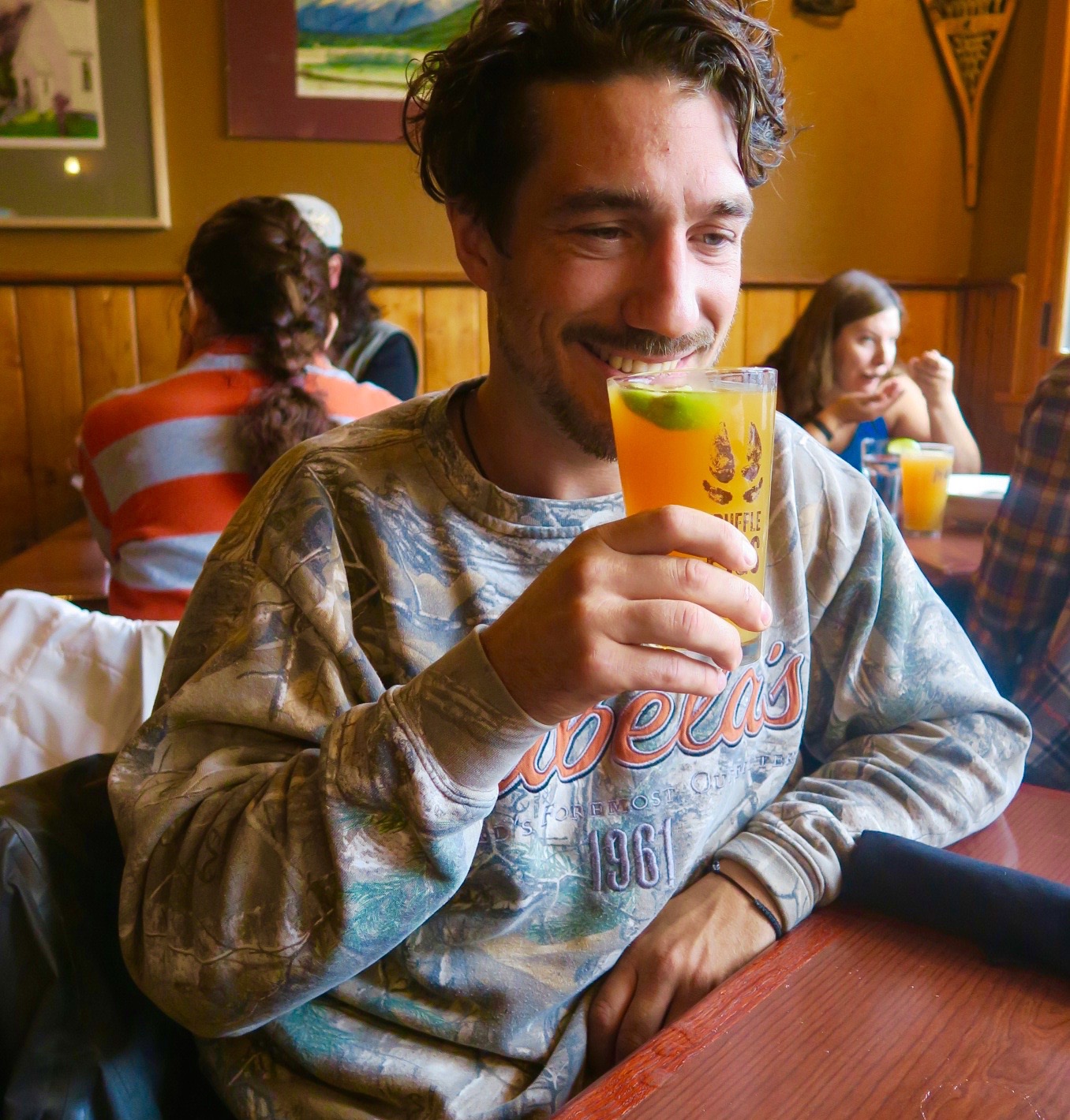
I usually stay away from veggie burgers, mostly on principle, but this beet burger was a Truffle Pigs original recipe and it was outstanding.
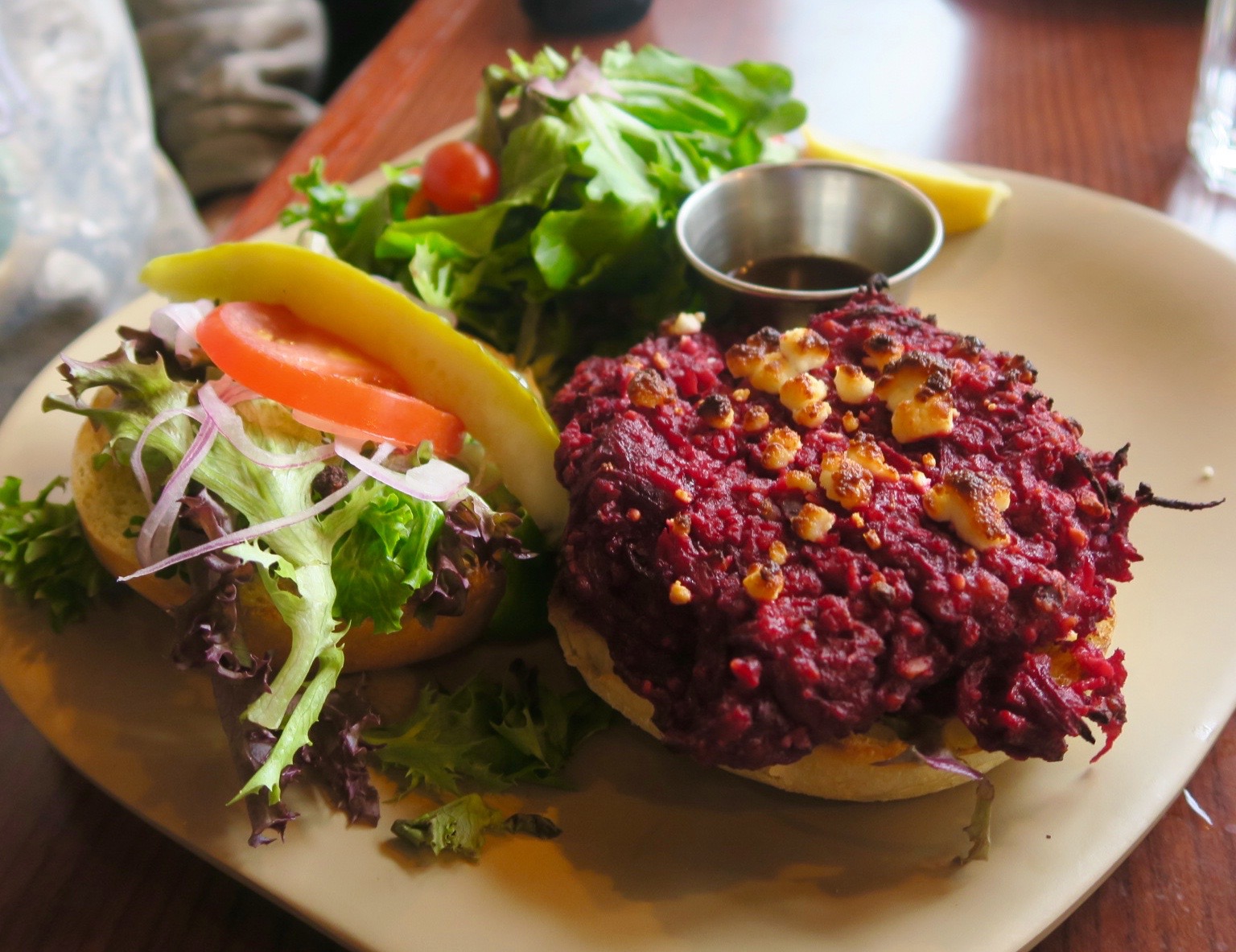
Our hunger sated we hit the road again for the short drive to Kicking Horse campground which is the only one of four in Yoho that is suitable for RV’s. Even so the sites are unserviced so we relied upon battery and propane power for our needs. There is a very well maintained shower and flush toilet facility at Kicking Horse.
With the RV in place we set out for the number one attraction of Yoho – Takakkaw Falls.
Takakkaw Falls is at the end of a 13.7 km. (8½ miles) paved road that is only suitable for cars and motorcycles. Here’s why.
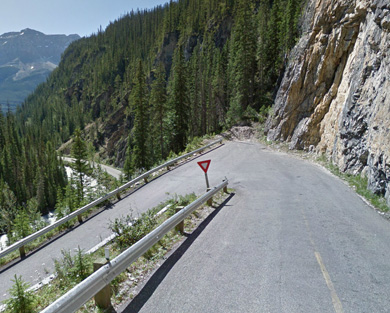
This switchback at about the halfway point is impossible for RV’s or trailers to navigate, although we were told that occasionally some nut would get around it by backing an RV up this stretch. I would not advise doing it unless you have a death wish. However, if you don’t have a car there are a couple of attractions worth seeing on the Yoho Valley Road before this hairpin turn.
The Spiral Tunnels
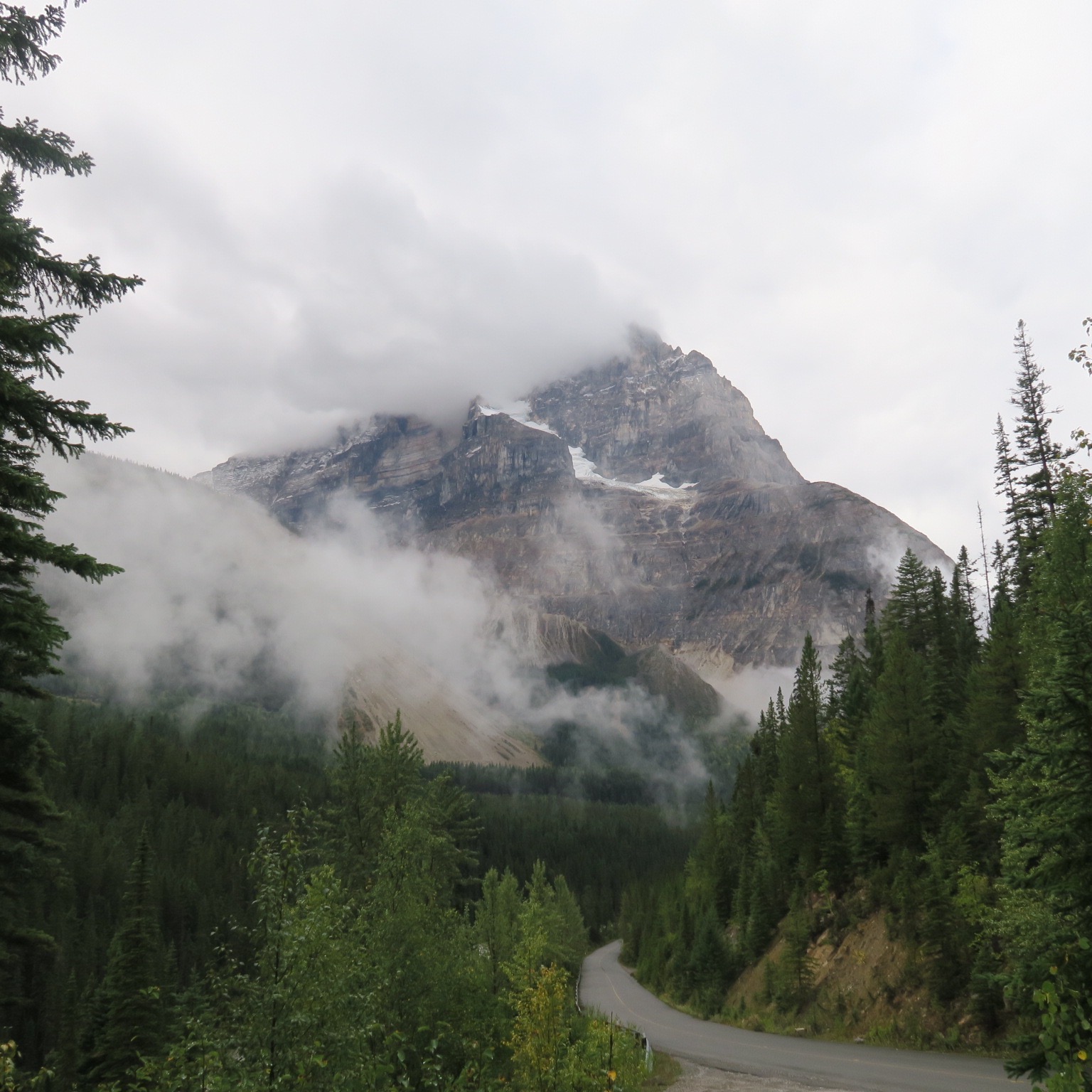
The first is a viewpoint from where you can watch the progress of trains as they navigate the world famous spiral tunnels of Kicking Horse Pass. This is the view we had on the day we were there so we could see no trains, but this video will give you an idea of why this is a worldwide attraction for railway buffs. This is the main CPR line in BC with upwards of two dozen trains a day, some of them hundreds of cars long, so there is a very good chance that if the weather is clear, you will get to see this amazing man made feat of engineering in action.
Meeting of the Waters, Yoho National Park
Just up the road from the spiral tunnels observation point there is a short steep path that leads down to the confluence of the Yoho and Kicking Horse Rivers.
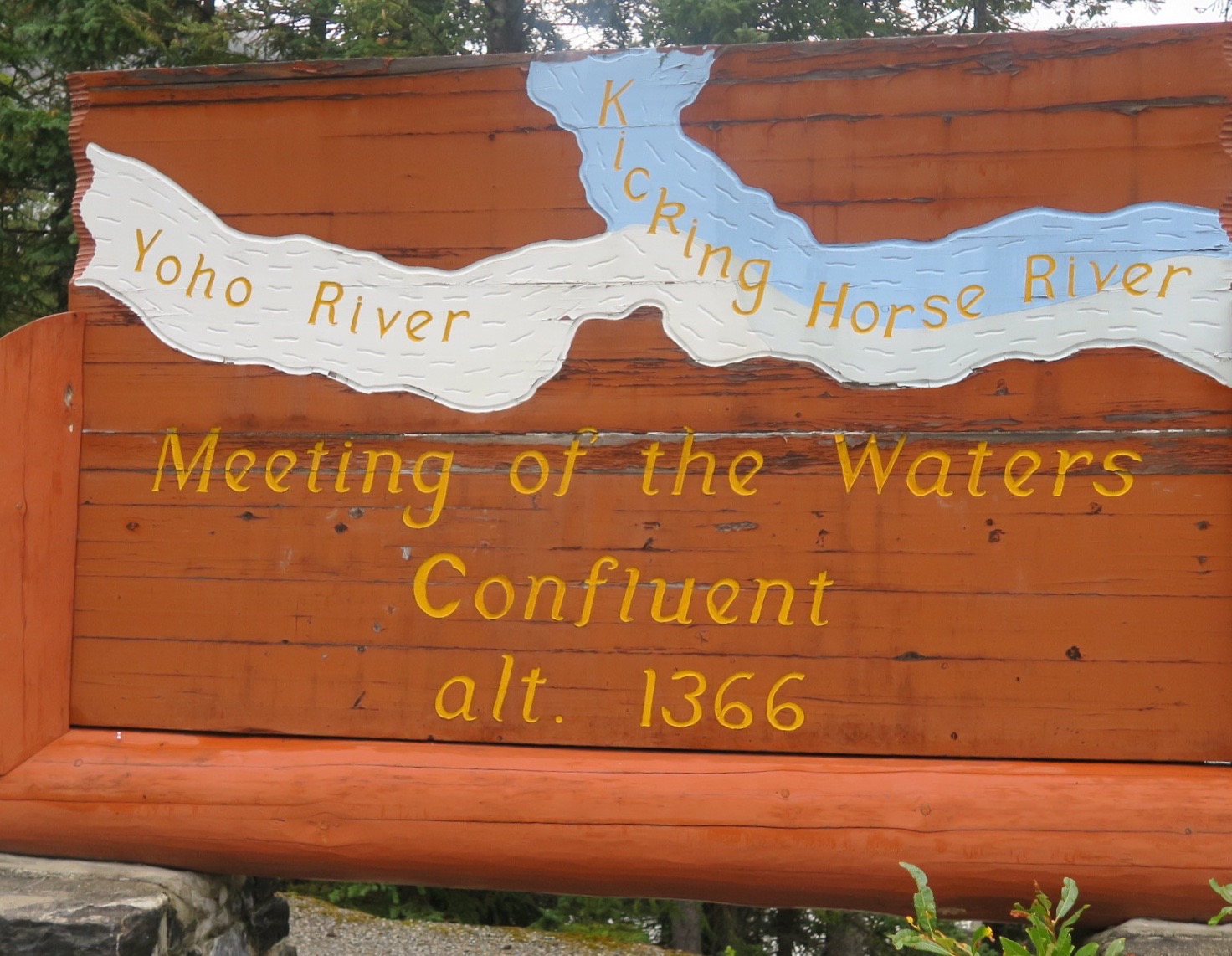
Given the heavy rains of the last two days it’s not surprising that both rivers are aroar and putting on a display that dwarfs the one we saw yesterday in Glacier National Park. Dale and Alex jump from rock to rock like mountain goats to get out in the middle of it. I restrain A.J. from following suit. The river coming in is the Yoho not long after these same waters plummeted over Takakkaw Falls.
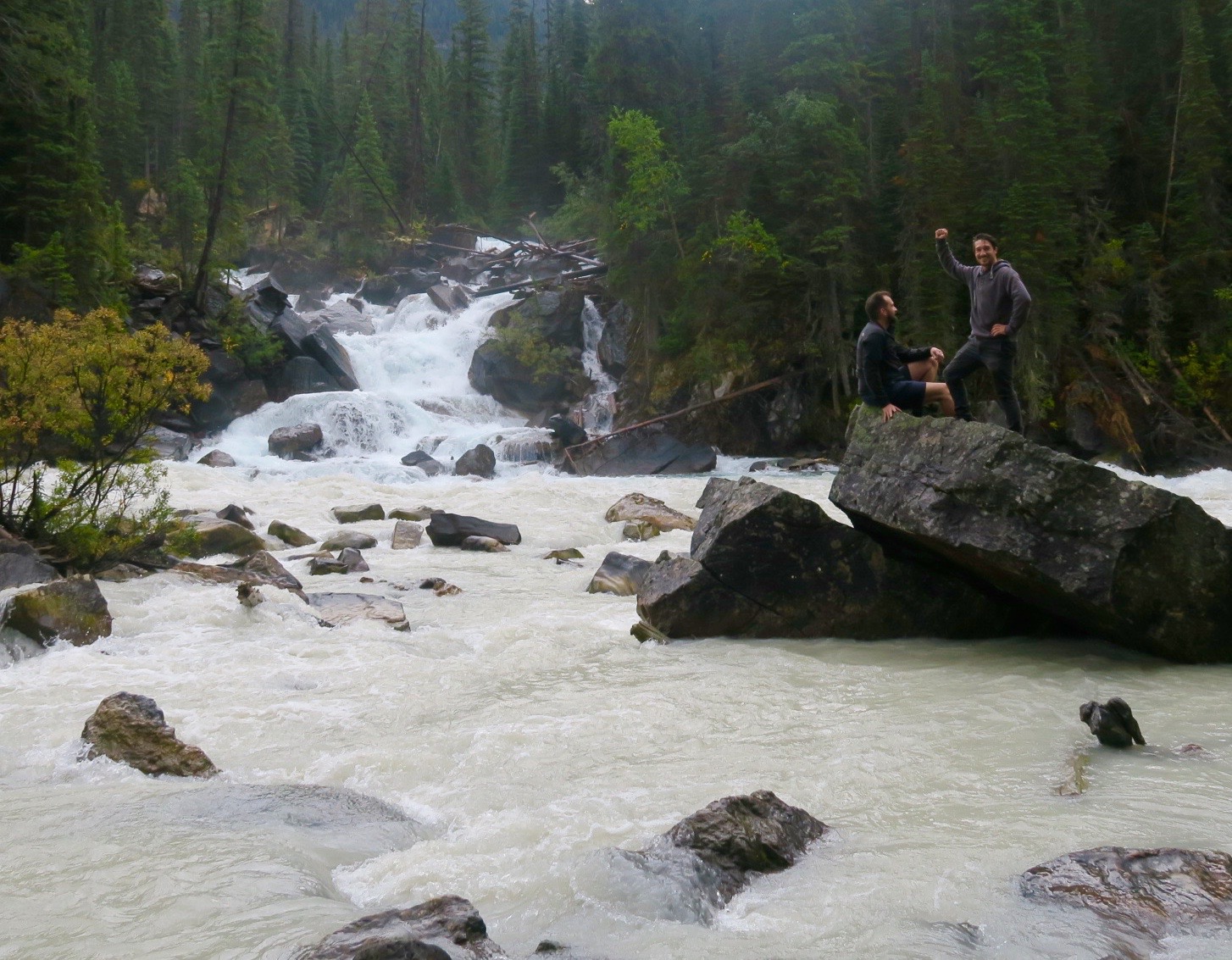
Takakkaw Falls
After navigating the aforesaid hairpin turn we make it to the parking lot for Takakkaw Falls and follow the crowds along the banks of the Kicking Horse River to a sturdily constructed foot bridge that crosses the river and then we see the falls. This is not b.s. – almost simultaneously Dale, Alex and I, all stand stunned and blurt of the word “Yoho”. I have never seen a more magnificent waterfall ever.
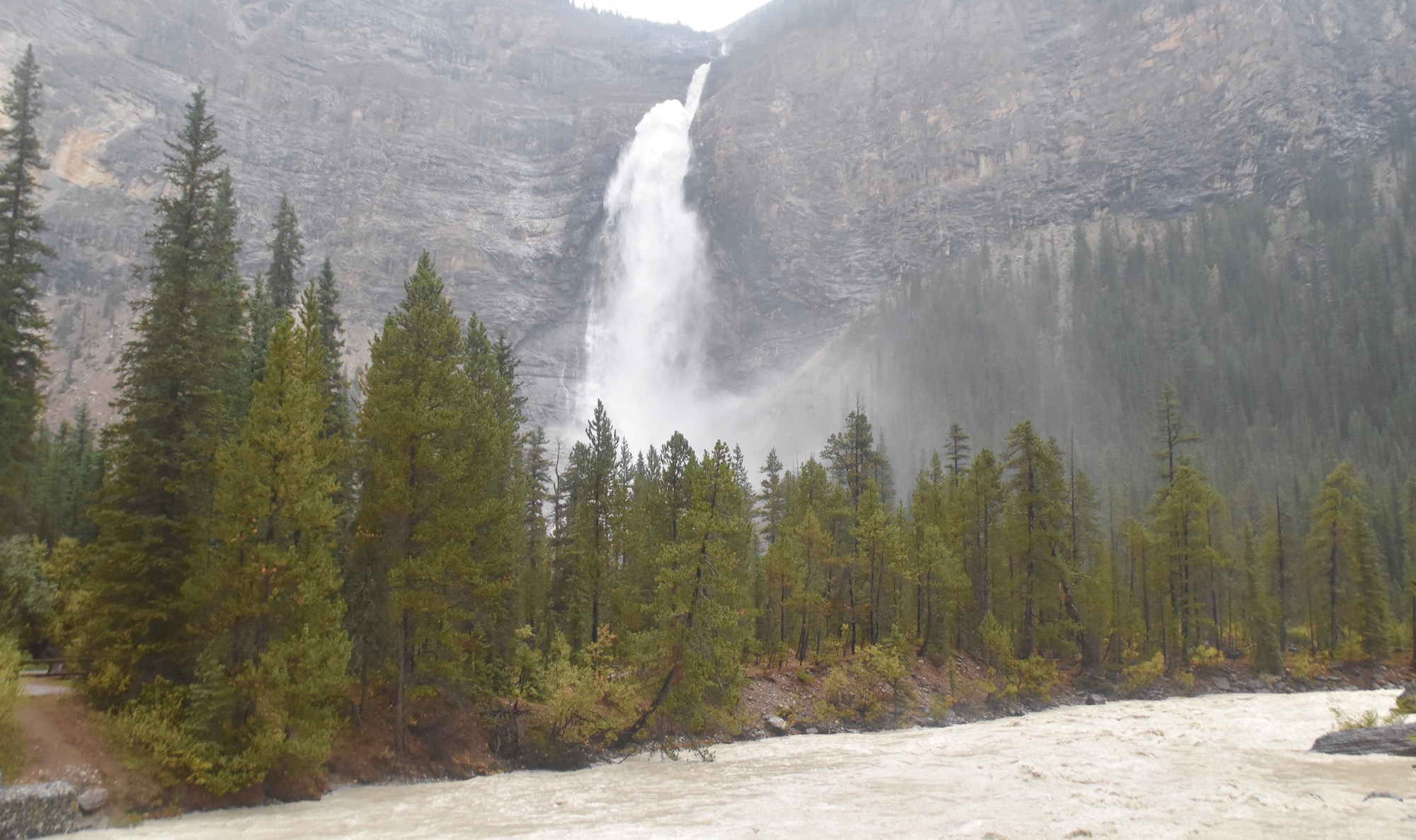
What makes Takakkaw so spectacular is not just its height – 380 metres (1246 feet) which makes it the second highest in Canada, but the fact that about a quarter of the way down the water hits some type of barrier that literally causes it to jet upwards. This is something I’ve never seen in a waterfall and it is a mesmerizing sight. After that the water drop a sheer 254 metres (833 feet) straight down.
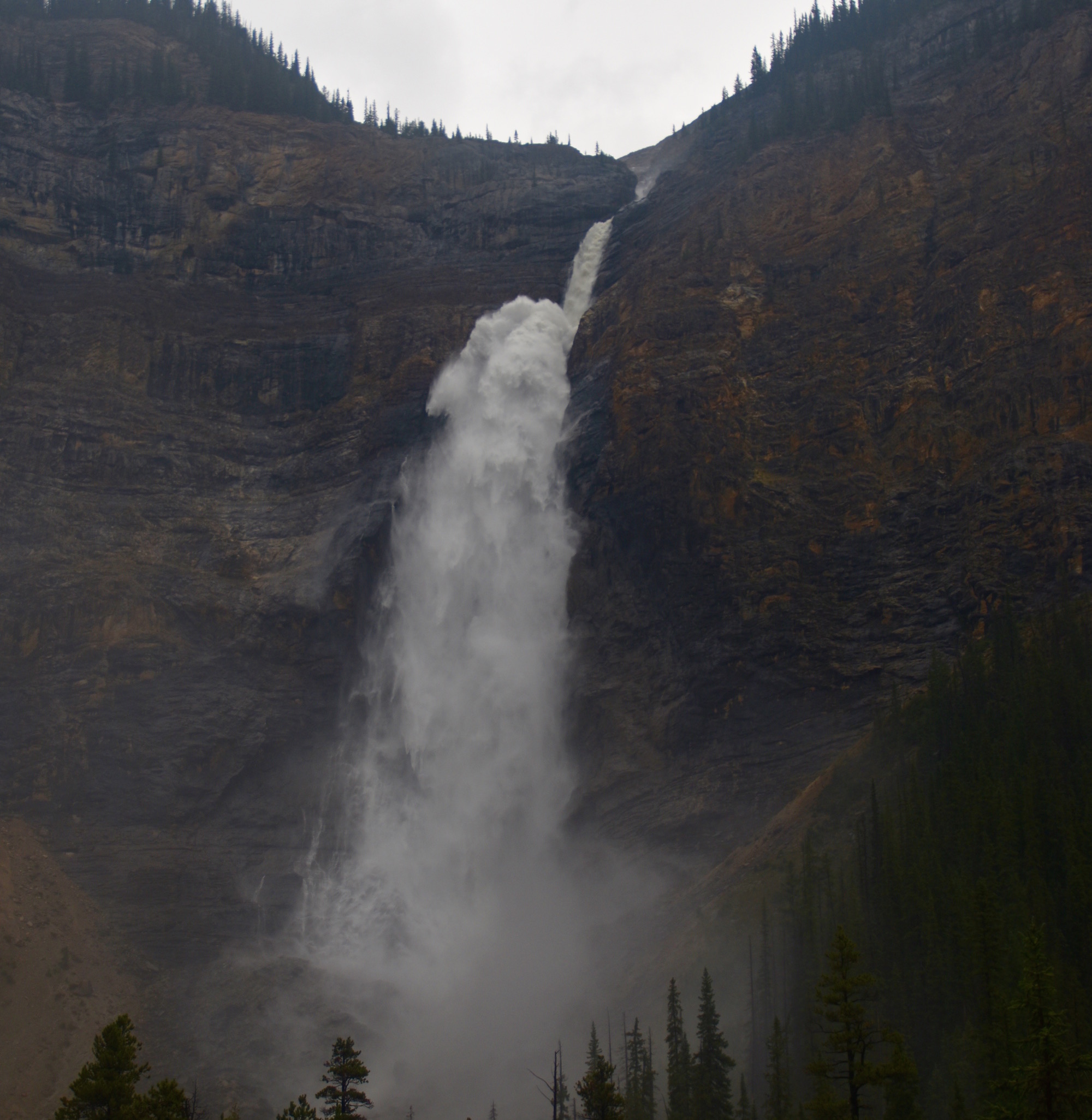
If there’s a better view from the Parks Canada red chairs than the one at Takakkaw, I’ve yet to see it.
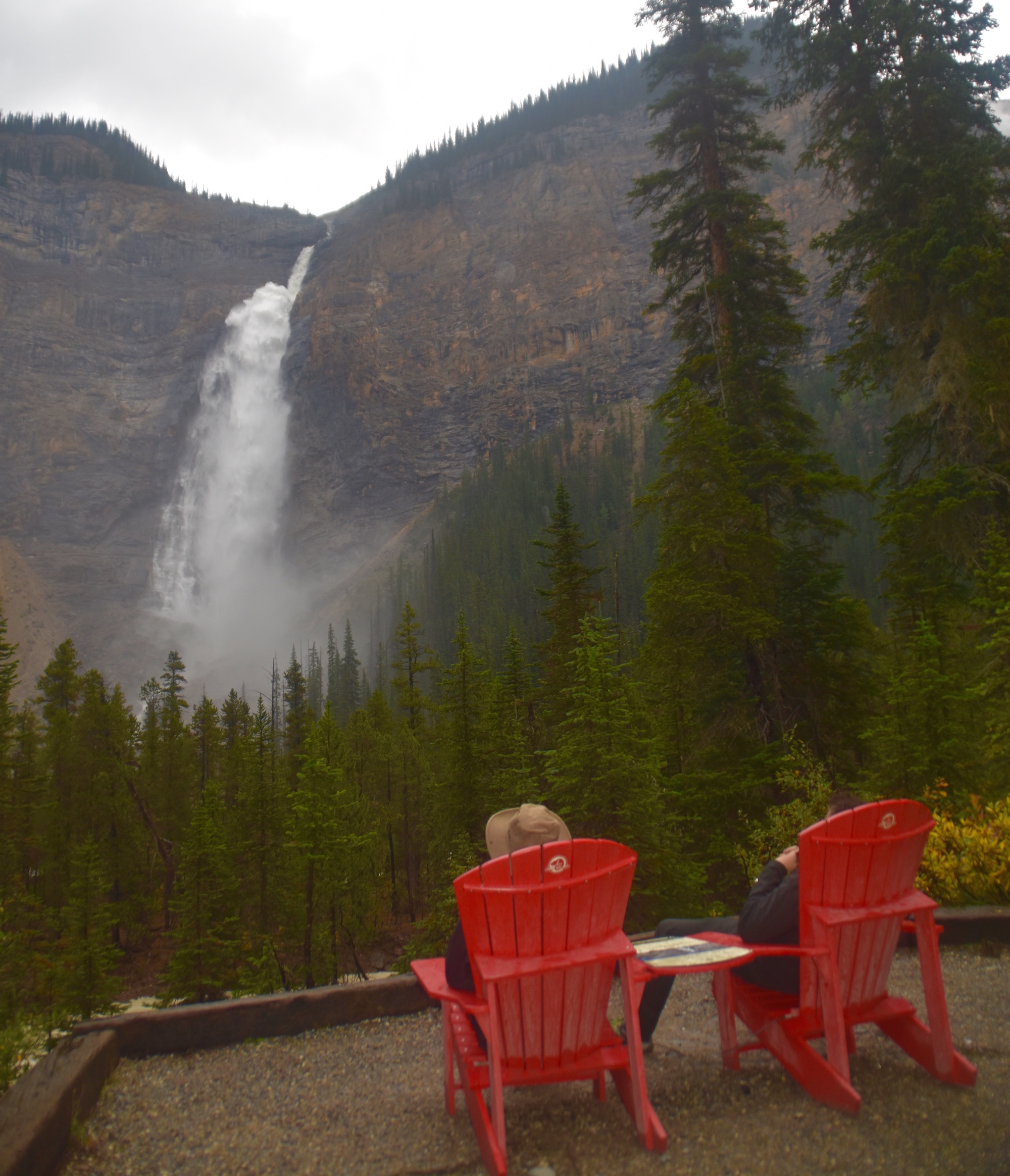
You can get as close to the bottom of the falls as you dare. Naturally Dale, Alex and A.J. take off and leave me behind which is OK by me because the falls whip up their own winds which, along with the mist, drops the temperature dramatically the closer you get to the base. This was as close as I was going to get. The picture is fuzzy because I couldn’t keep the mist away from the lens.
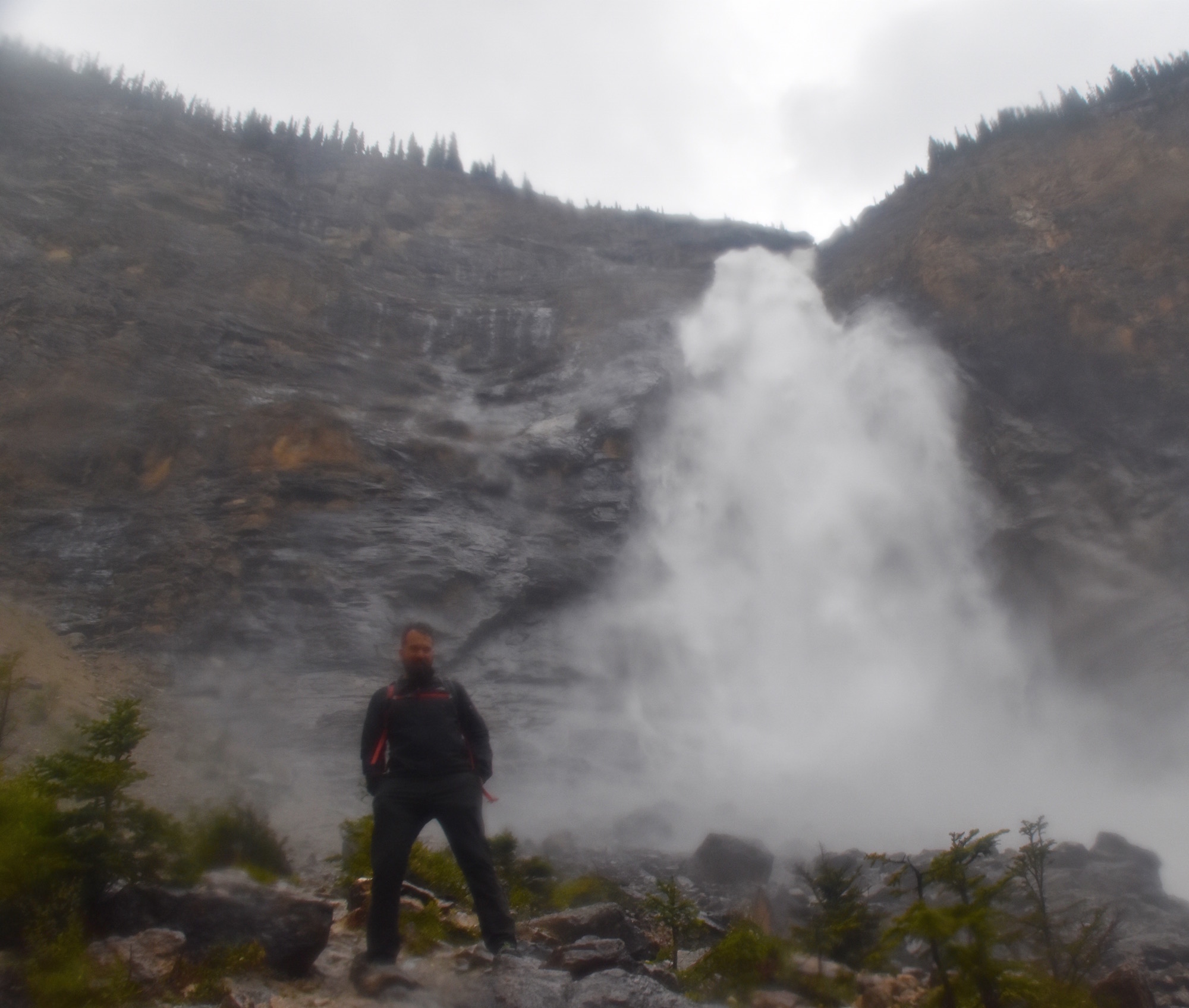
We spent a lot of time at Takakkaw Falls – after waiting 66 years to see it, I, for once, was not in a rush to leave. It was getting dark as we descended the Yoho Valley road and back to the RV at Kicking Horse campground. It was another night of home cooking accompanied by B.C. wines and craft beer. Life is good.
The next morning I saw something I hadn’t seen since arriving in Kelowna four days earlier – the sun! My God the mountains are beautiful when you can actually see them. We have the whole day to continue exploring Yoho National Park and we set out early for the other major side road in the park that leads to Emerald Lake.
Natural Bridge, Yoho National Park
Our first stop is at the Natural Bridge which is not an attraction I was aware of until planning this trip. Again it’s one of those wonders of nature that has to be seen to be believed and appreciated. This is the view of the Kicking Horse River from the bridge on the Emerald Lake road. There is so much dissolved material in the water that it looks more like milk than water.
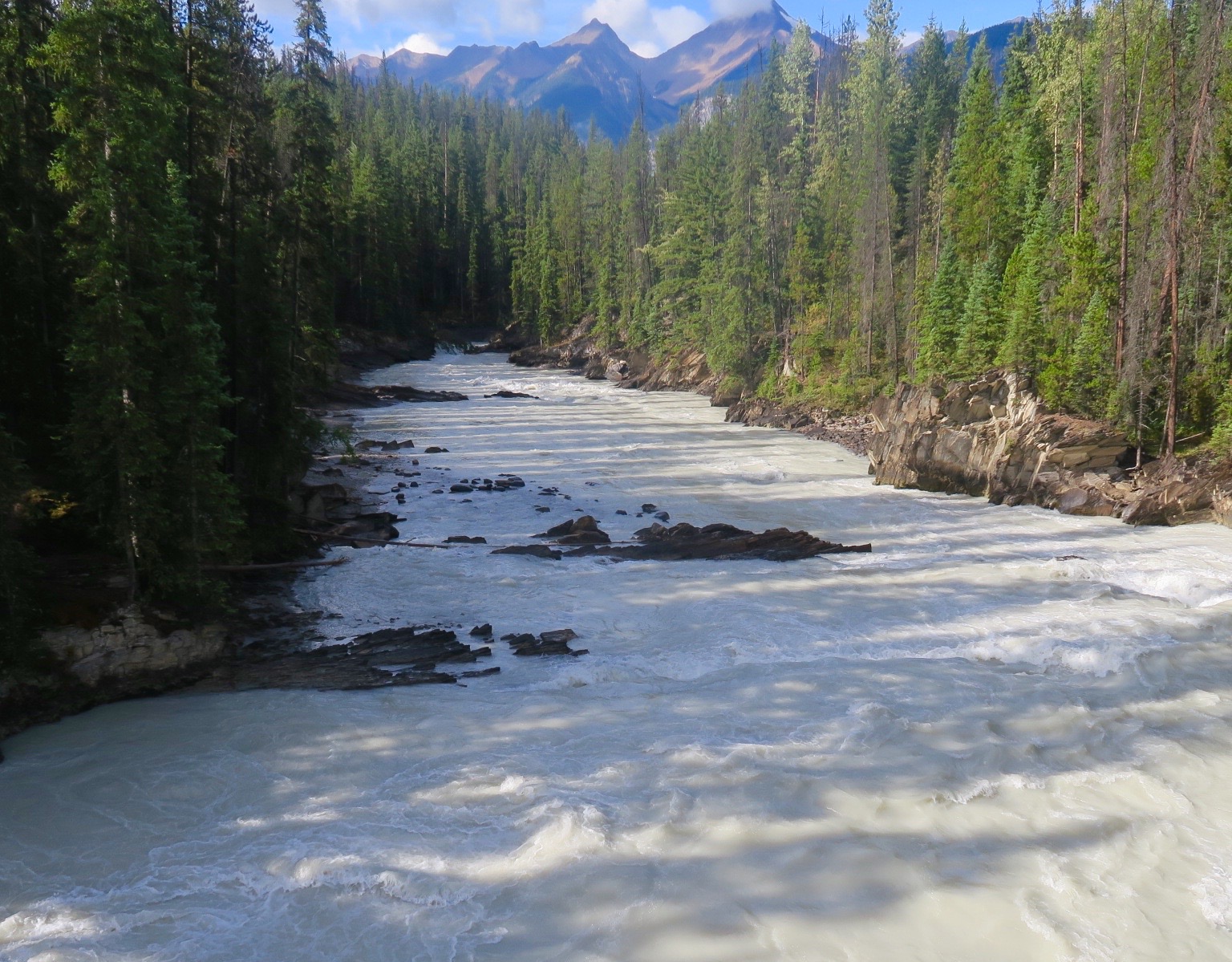
The Natural Bridge is just that – a bridge that has been carved out of the stone by the erosional force of the water. Imagine all that water you see in the photo above being forced to go through a channel only a few feet wide and you get this.
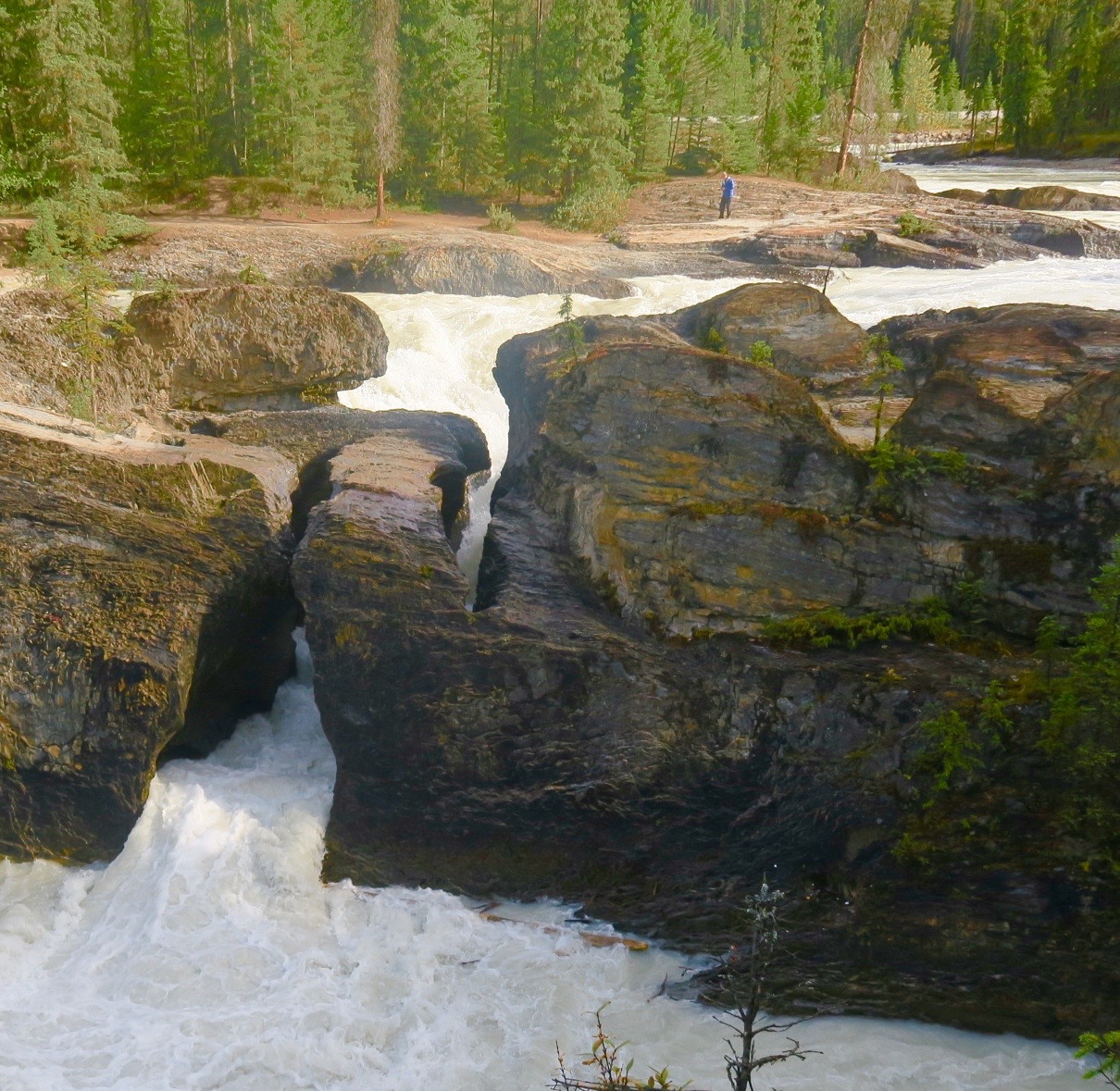
Despite looking inherently dangerous or maybe because of it, Dale and Alex are immediately drawn to get as close a look as possible.
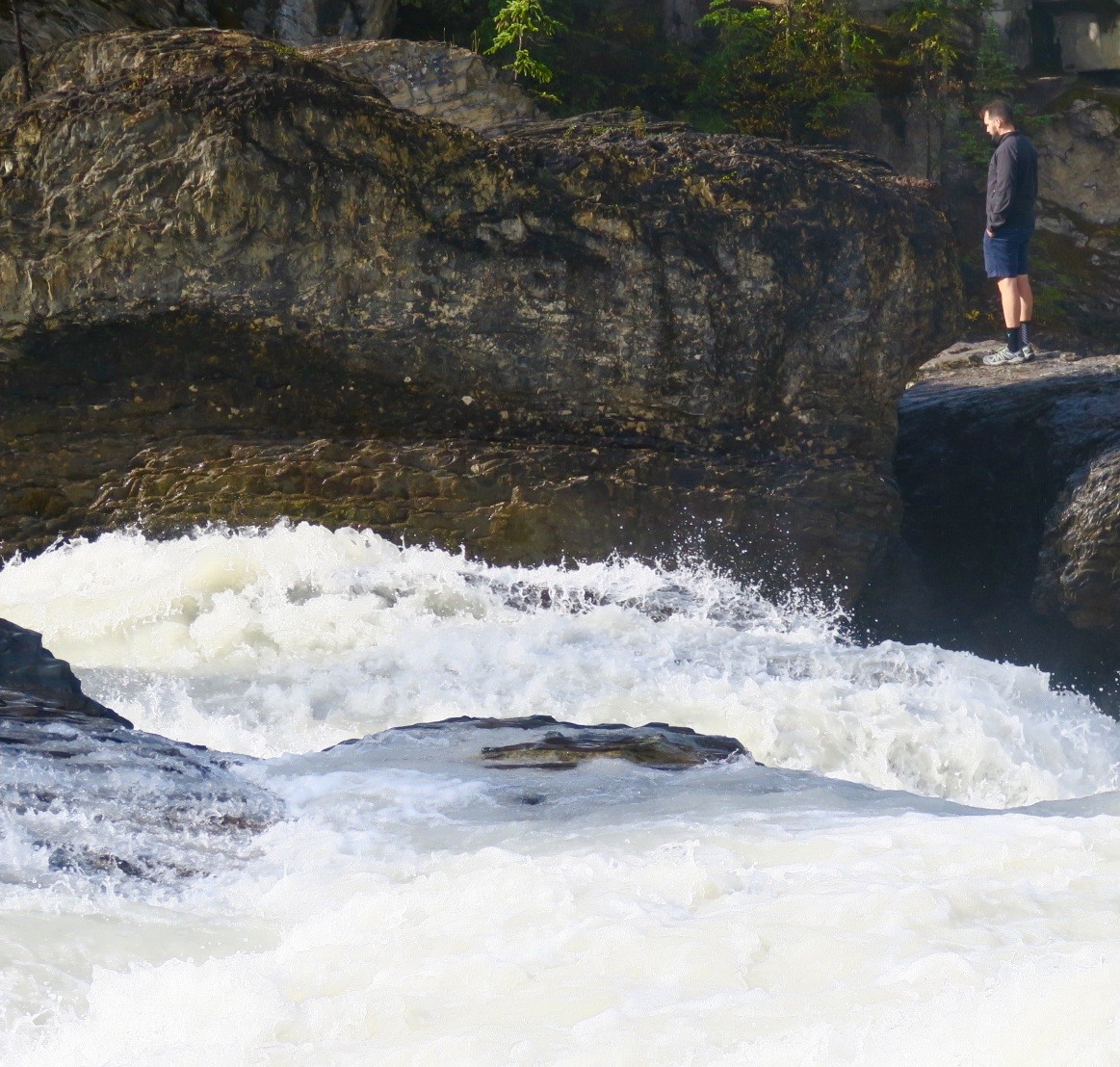
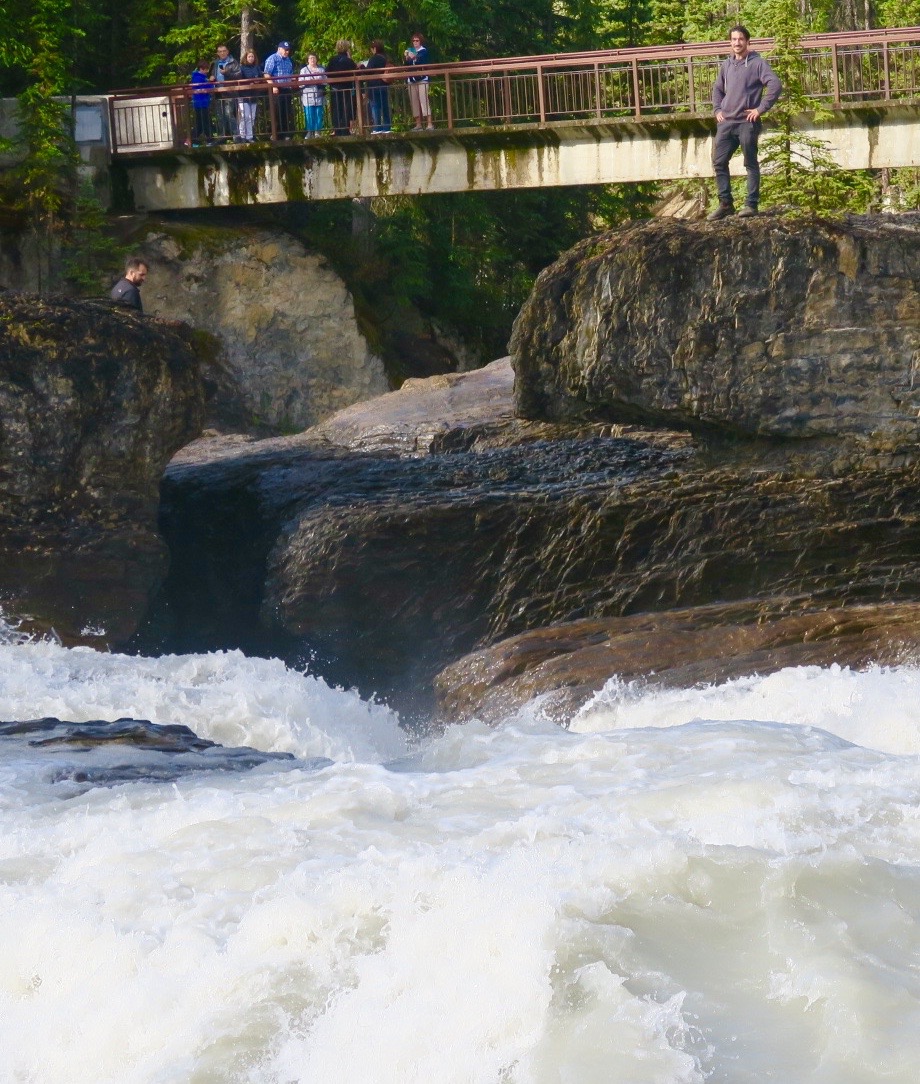
Alex takes A.J. around to the far side of the bridge and despite my warnings not to go any further stop for this photo.
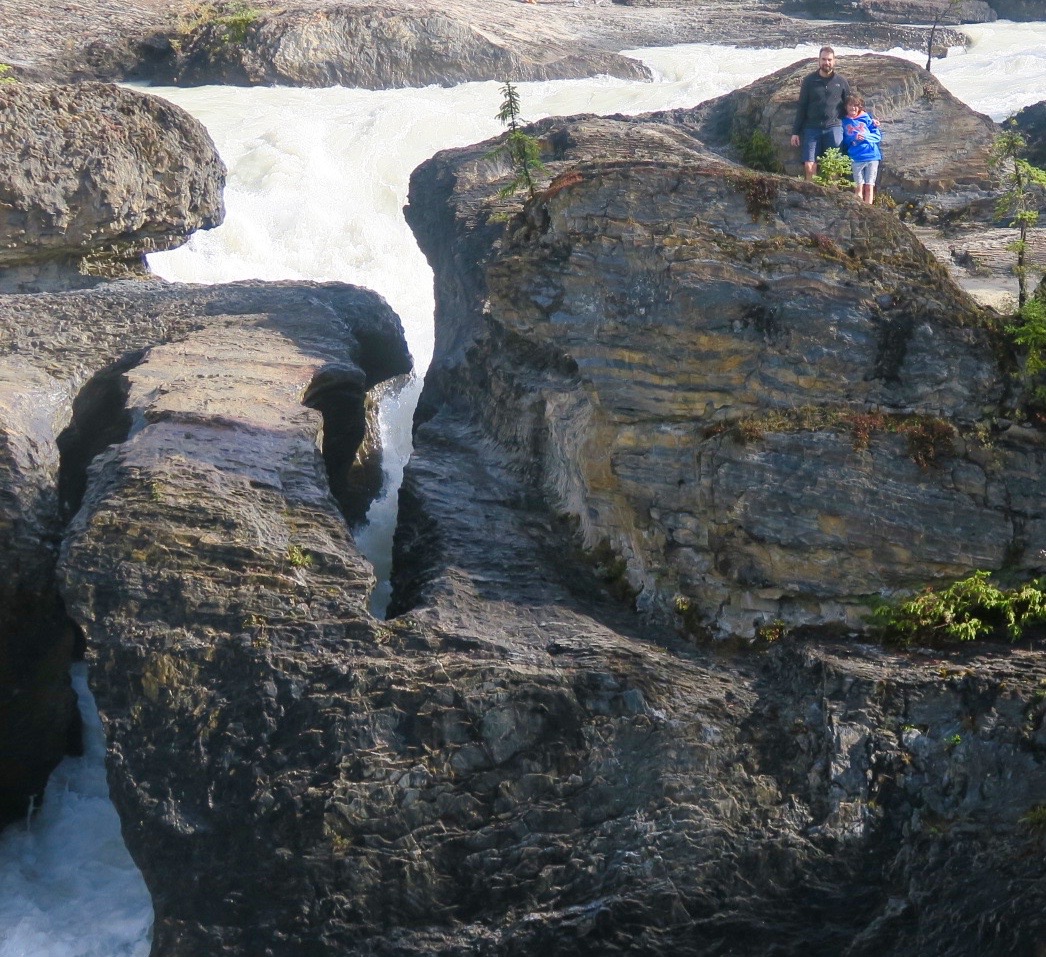
Even though it is a real bridge in terms of being one continuous piece of rock under which the river flows, you can’t just walk over it, but need to jump across one section where the sides are very steep and one tourist does just that which leaves everyone watching agape. One false step and that guy would be dead for sure. I motion to Dale and Alex to not even think about it and for once, they listen.
Emerald Lake, Yoho National Park
The Canadian Rockies are justly famous for having some of the most beautiful lakes in the world, Lake Louise long being the number one attraction. Unfortunately Lake Louise is being loved to death. When we passed by later on our way to Kootenay National Park, not only was the main parking lot full, but so was the overflow parking lot which is miles away from the lake. And this was during the shoulder season.
Fortunately, Lake Louise is not the only opportunity to observe, walk around, canoe, kayak or fish on one of our fabled emerald green lakes flanked by mountains on all sides. At Emerald Lake you can do all those things, and while you certainly won’t be the only ones doing it, the crowds are minuscule compared to Lake Louise. The walk around Emerald Lake is an easy, mostly flat 4.6 km. (almost 3 miles) trail that is simply one of the nicest in Canada or the world for that matter. The green colour of the water comes from the amount of ground rock flour in suspension which in turn reflects sunlight. This is why Emerald Lake looks fantastic on a sunny day and that’s exactly what we have today.
Here are photos of our hike around the lake.
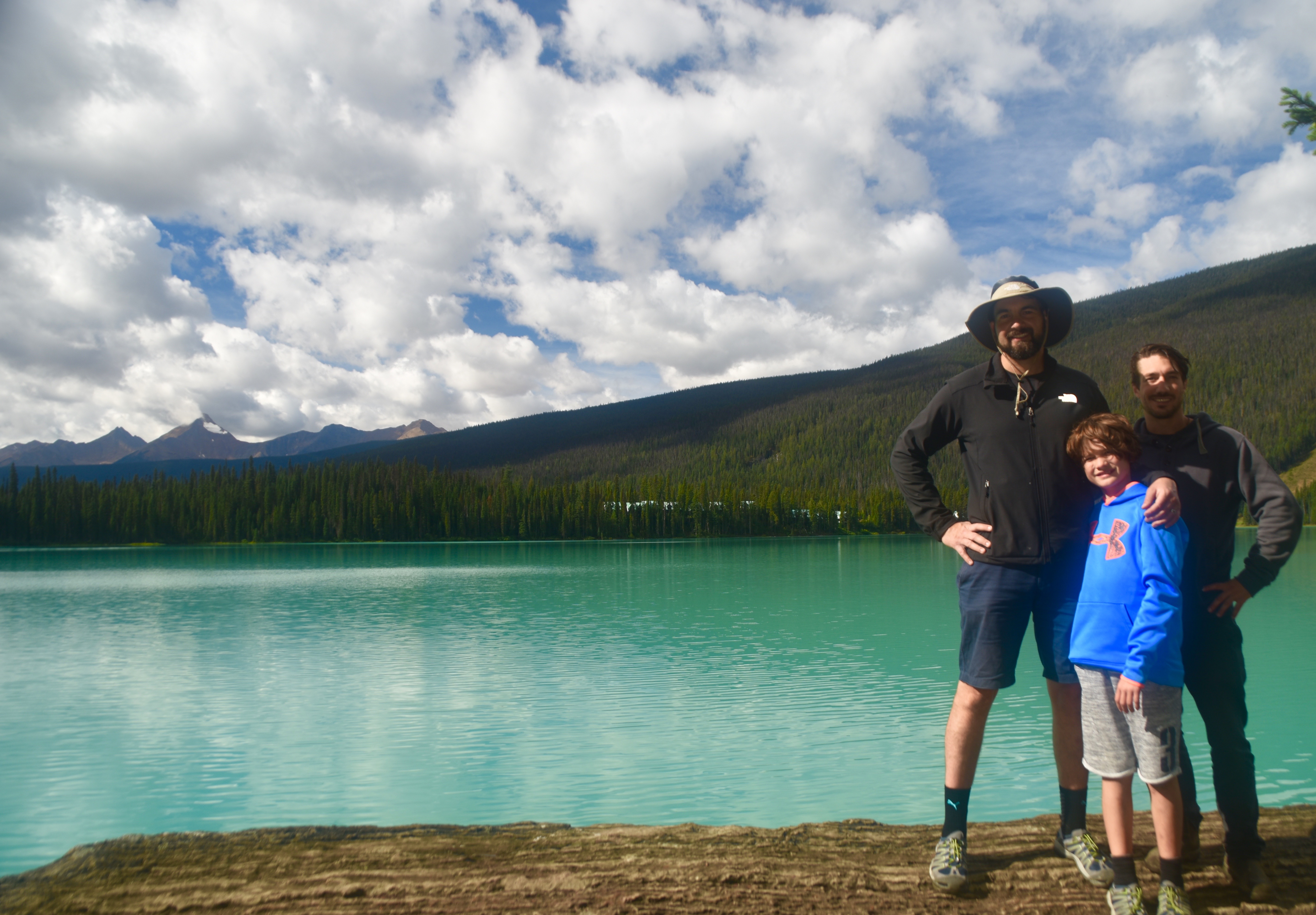
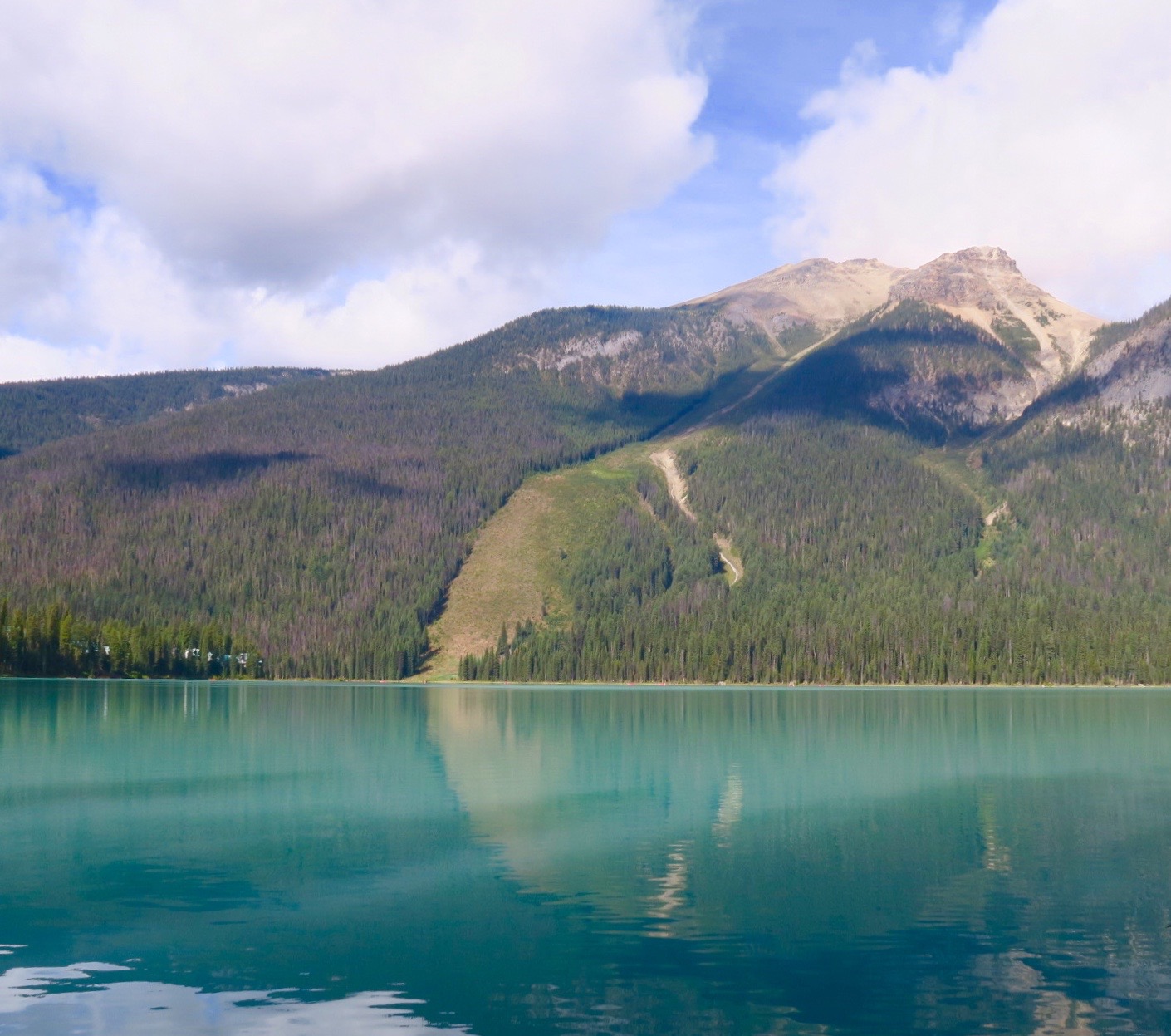
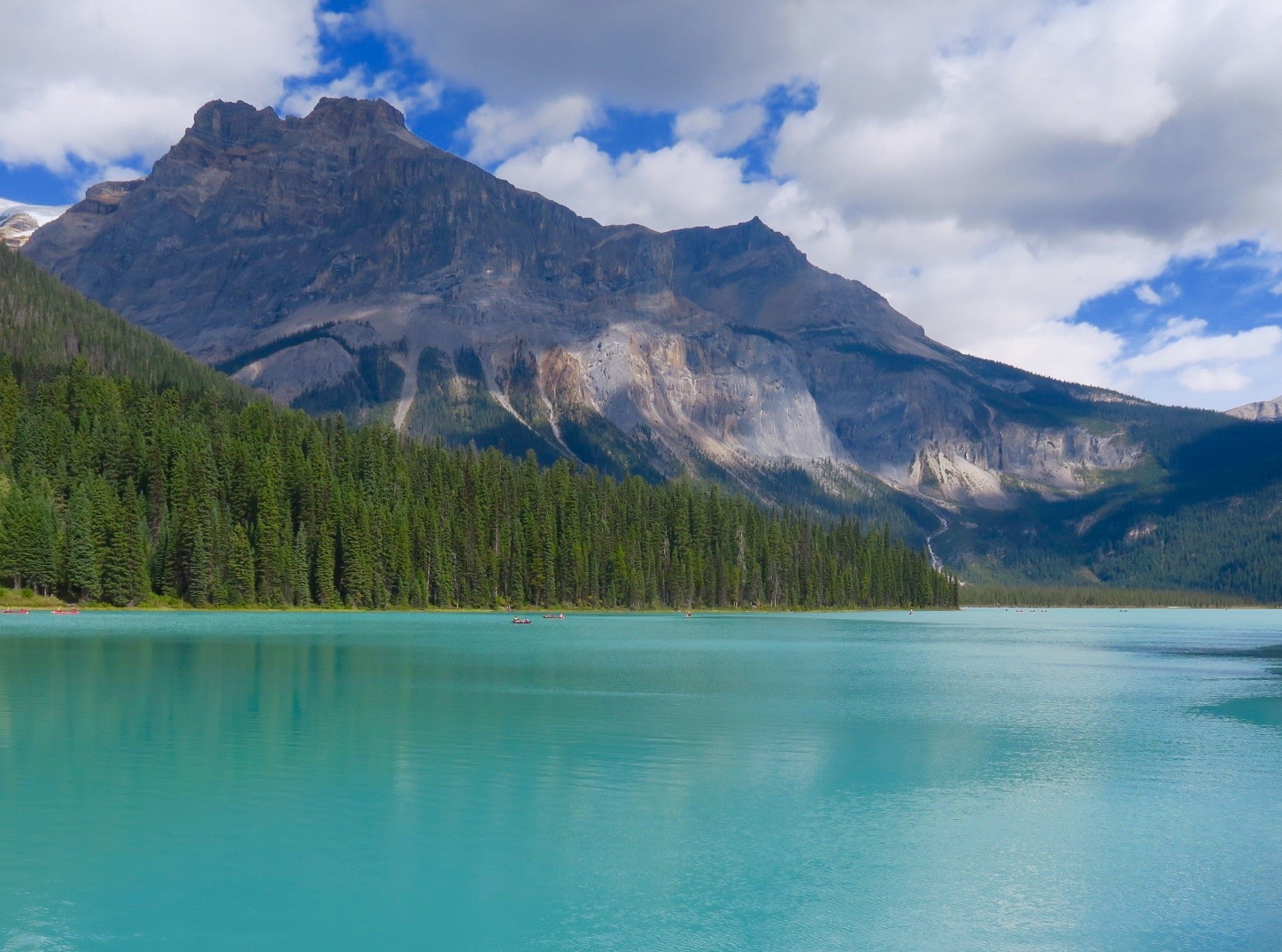
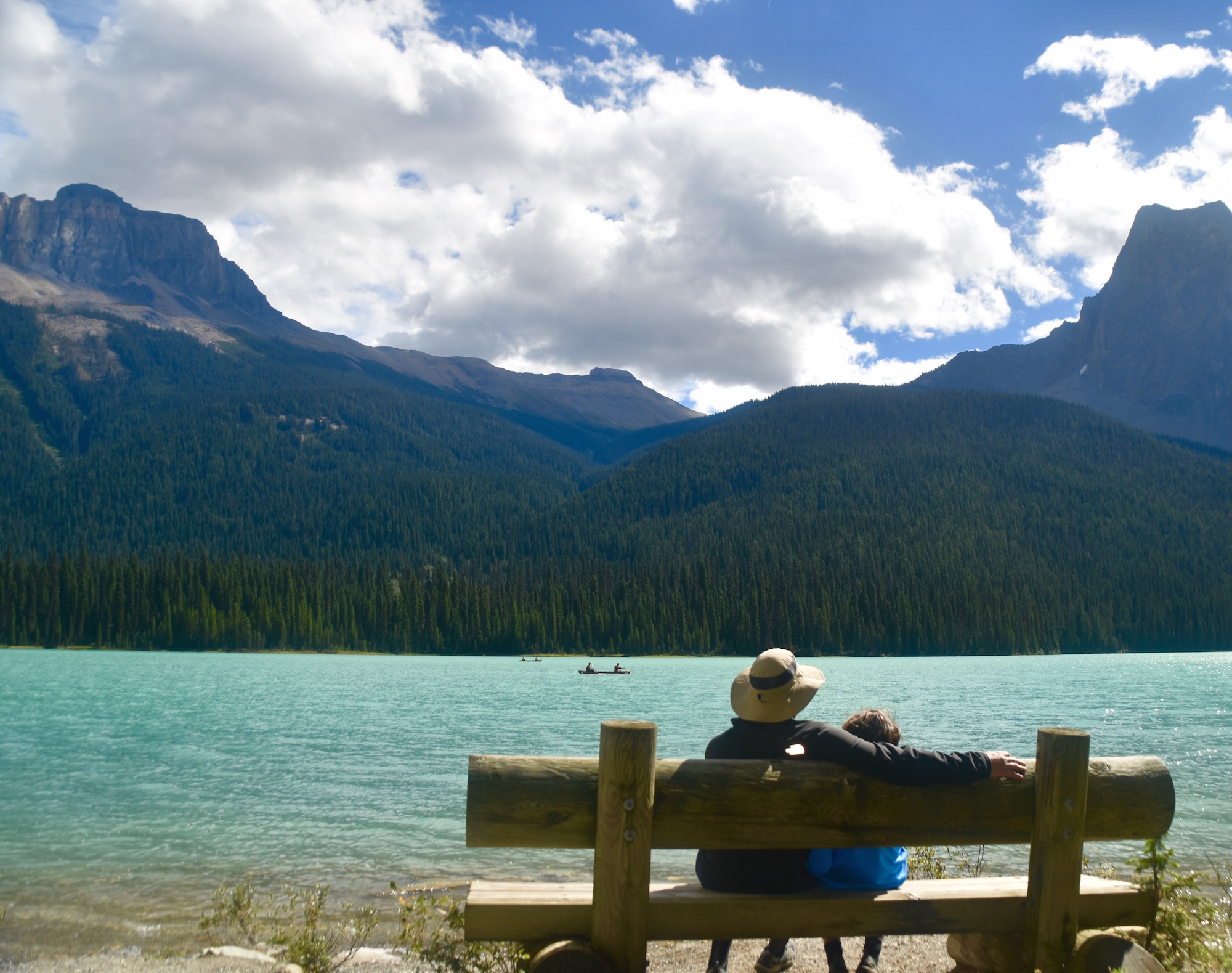
And one AJ photobomb.
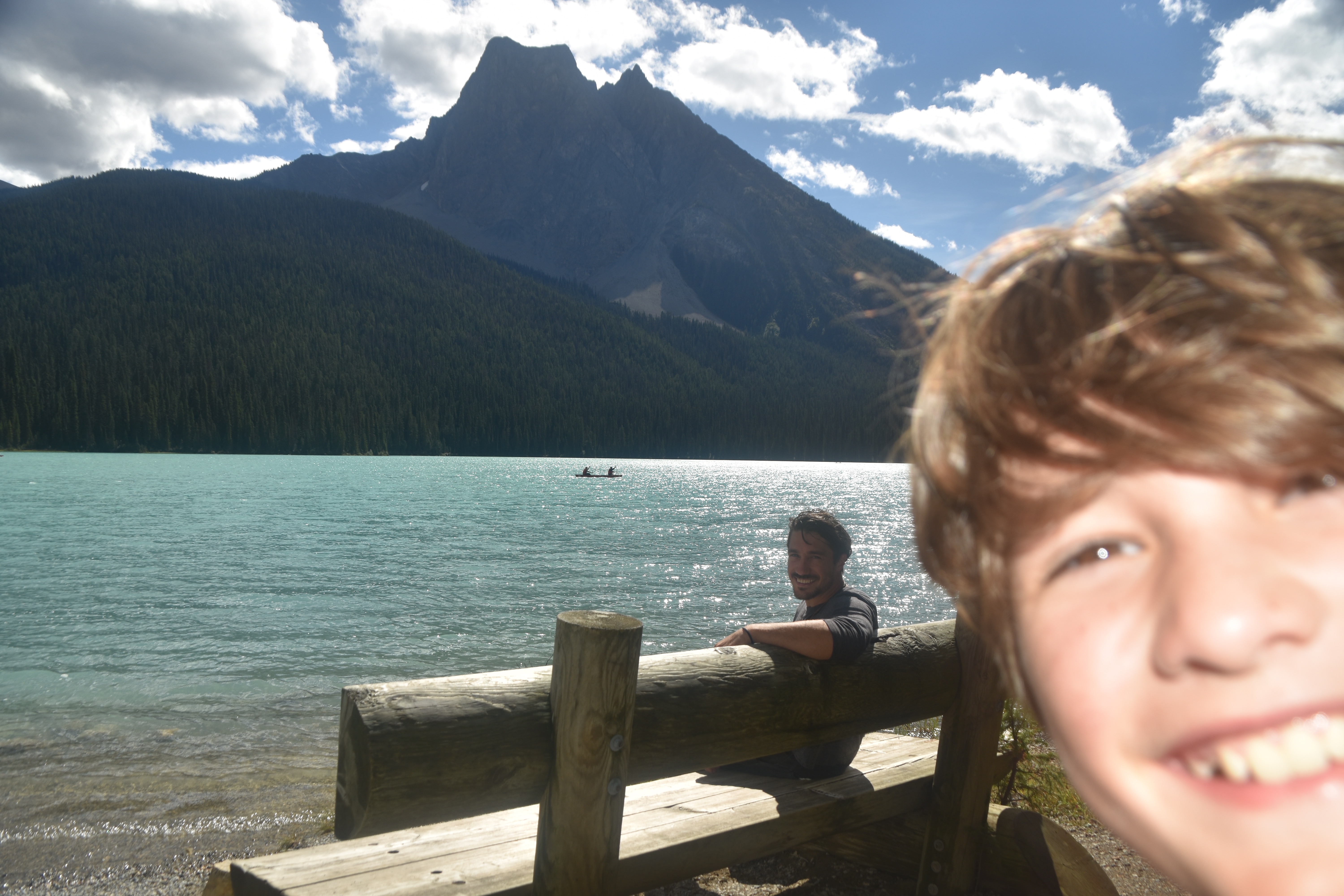
Emerald Lake is also close to the scene of one of the most important fossil finds in all of palaeontology – the Burgess Shale. That’s Mount Burgess rising up behind Emerald Lake and Parks Canada does provide guided tours, although the hike is quite demanding. We’ve decided to visit another section of Burgess Shale in Kootenay National Park and I’ll be writing about that in the next post.
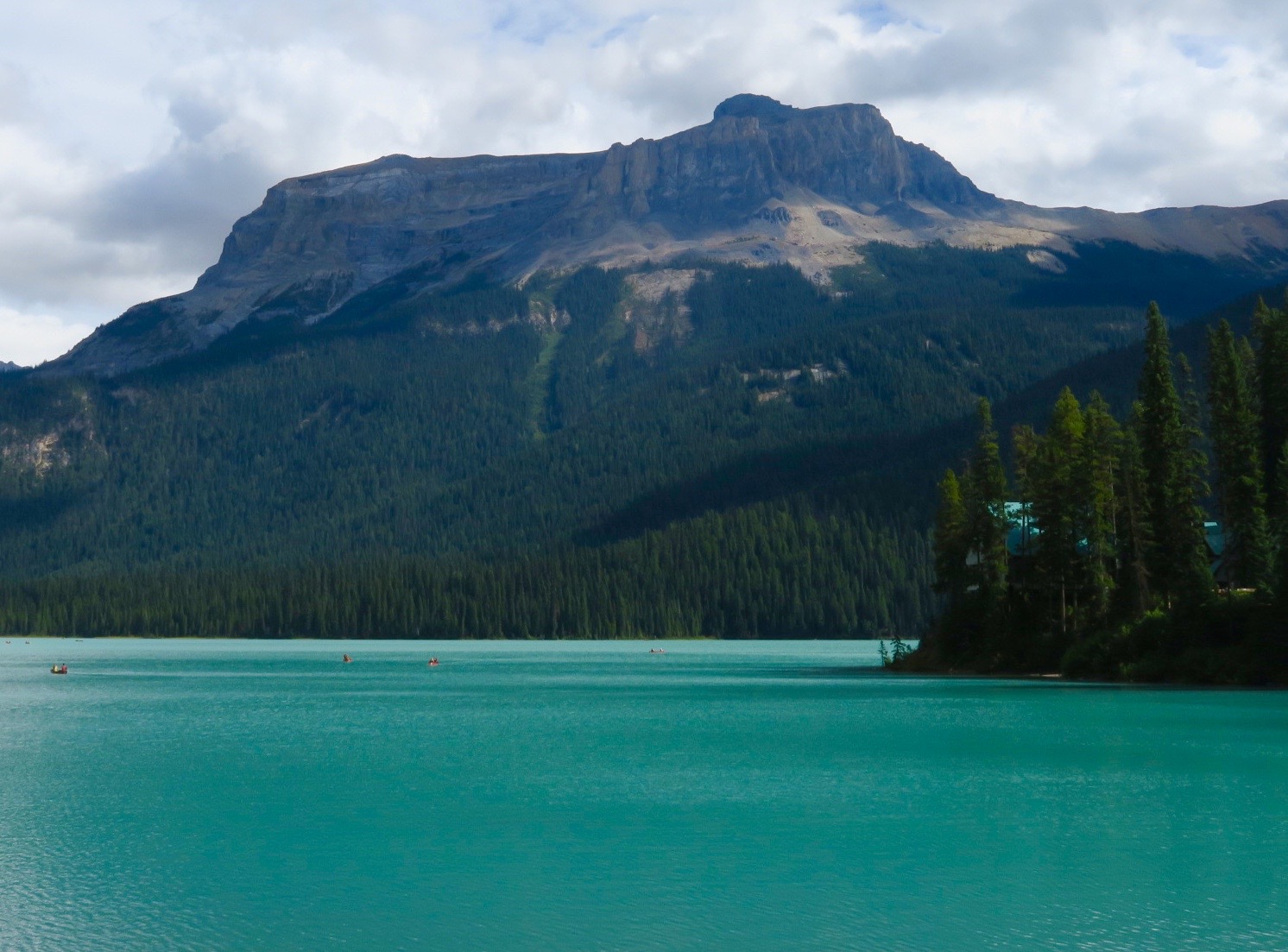
At the head of the trail around Emerald Lake you can rent canoes and kayaks, have a meal or stay at one of those legendary Canadian mountain resorts, Emerald Lake Lodge. The hiking trail passes right by the lodge and having seen it, I will definitely return with Alison at some future time. It is the very definition of a romantic place to stay.
Alas, that is the end of my time with the boys in Yoho. Dale has to return to Nelson and Alex, AJ and I are off to Kootenay National Park. However, as noted, I did return to Yoho three days later with Alison as my hiking companion.
Wapta Falls
It was raining so hard when we first entered Yoho National Park that we passed on the hike to Wapta Falls which was on my must-see list. Three days later the RV was parked at Redstreak campground on the outskirts of Radium Hot Springs and Alison had arrived from Calgary in the interim, while Alex and AJ headed back to Edmonton. Despite being over 175 kms. (108 miles) away, I still wanted to visit Wapta Falls so we drove the very pleasant Highway 95 up to the TCH and back into Yoho.
The trailhead is down a dirt road to a parking lot that will hold about twenty cars. It was fairly busy on the day we visited, but not to the point that it detracted from our or their enjoyment of the both the walk and the falls. The hike is fairly level with a few ups and downs once you reach the first overlook where you can see the falls. The distance varies depending on how close to the falls you want to get. It’s just over a mile to the first overlook and from there you can make your way down to a number of other viewpoints and almost to the base if you want.
On the way in we spotted this red-naped sapsucker which went about its sapsucking business quite oblivious to our presence.
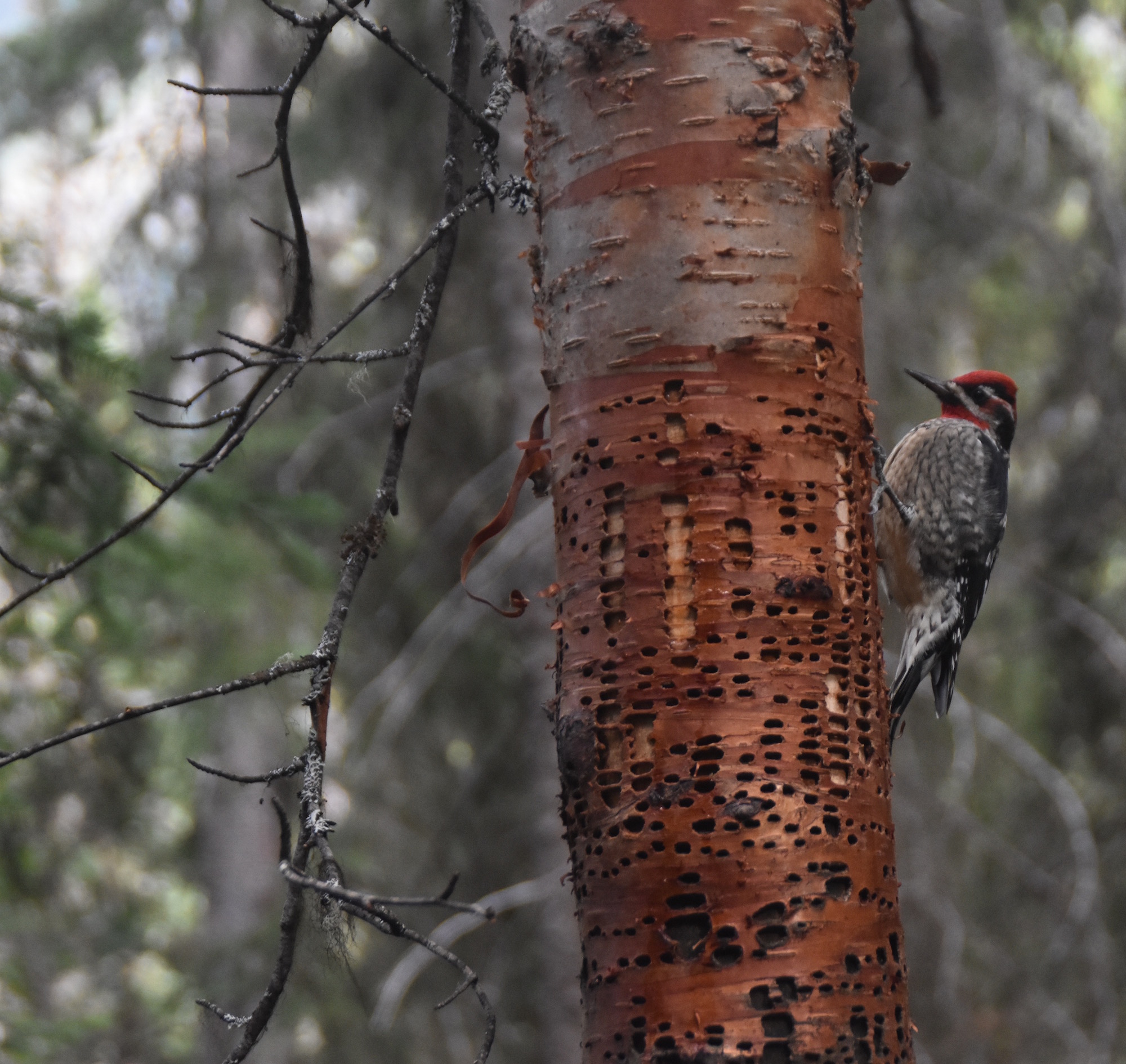
Since it was another sunny day we could see the mountains once we reached the first overlook.
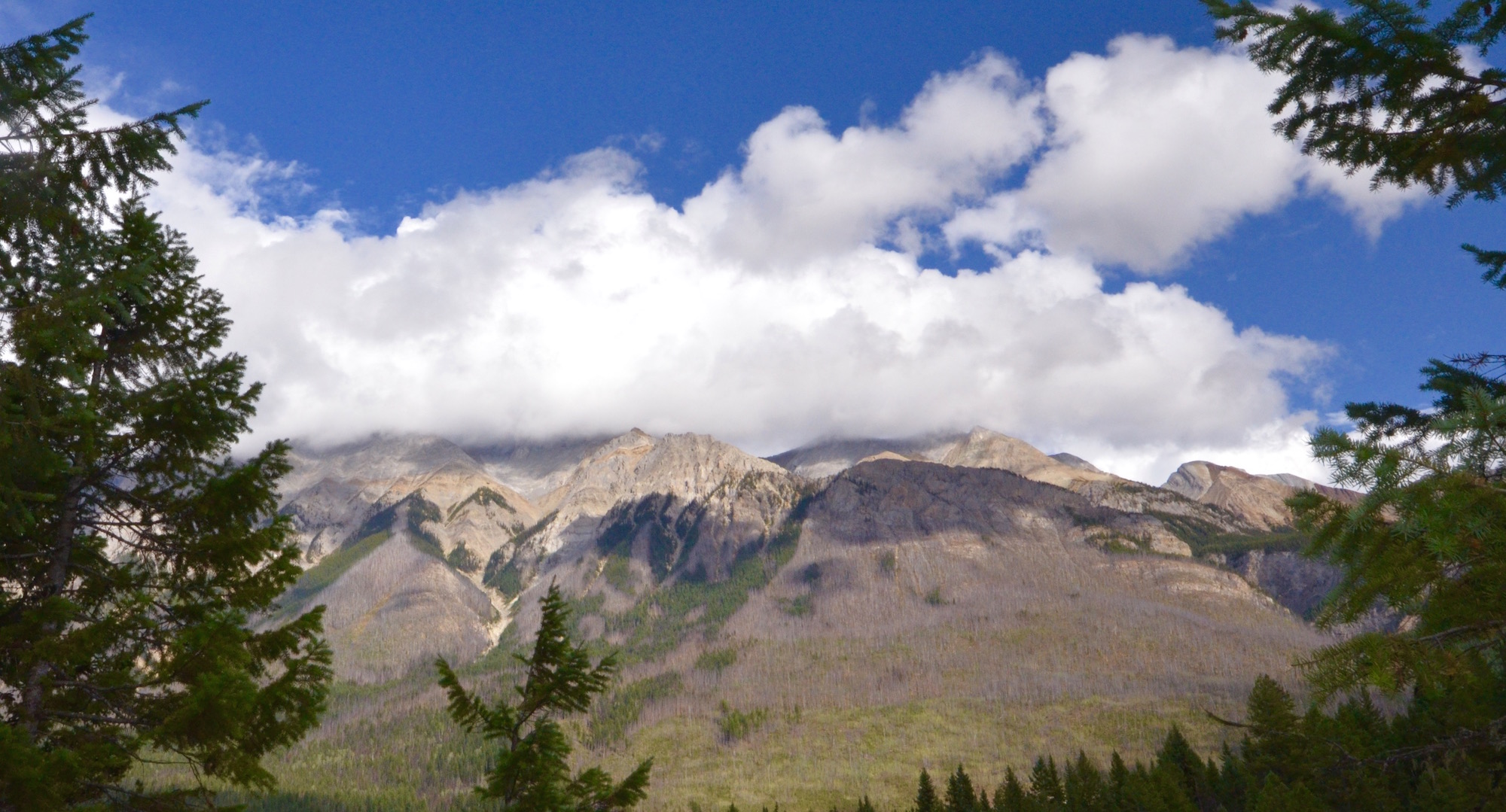
Wapta Falls is the antithesis of Takakkaw, which I would describe as having a feminine side; you often see the term bridal veil applied to the slender wispy waterfalls that plunge hundreds of feet. On the other hand, Wapta Falls are definitely brawny. While the elevation of the falls is 30 metres (about a 100 feet), the width is 152 metres (almost 500 feet) which is pretty impressive. The volume of water passing over Wapta Falls is immense and you can hear it long before you see it. This is the first view from above.
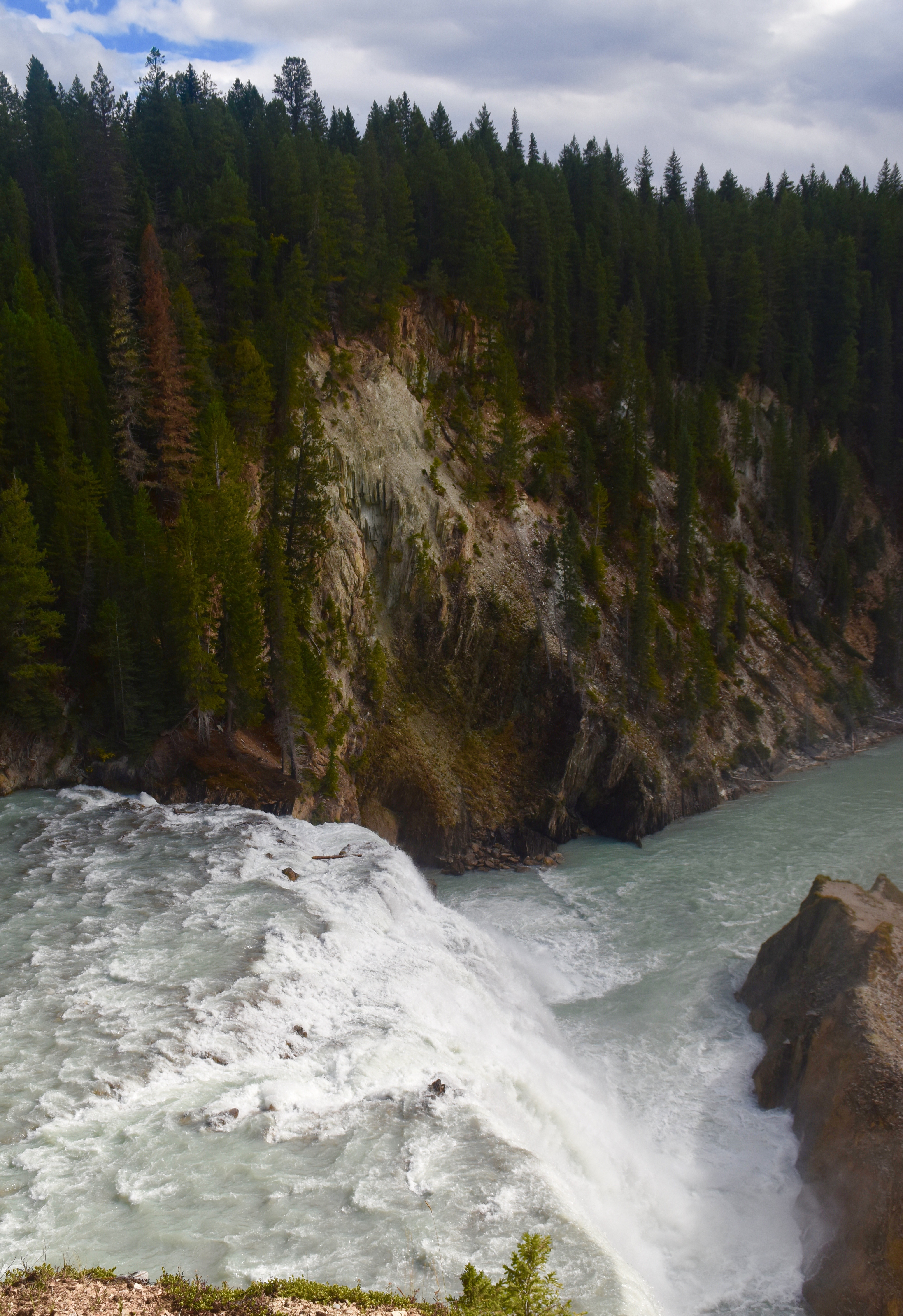
From below, on sunny days there is an ever present rainbow which draws people closer and closer.
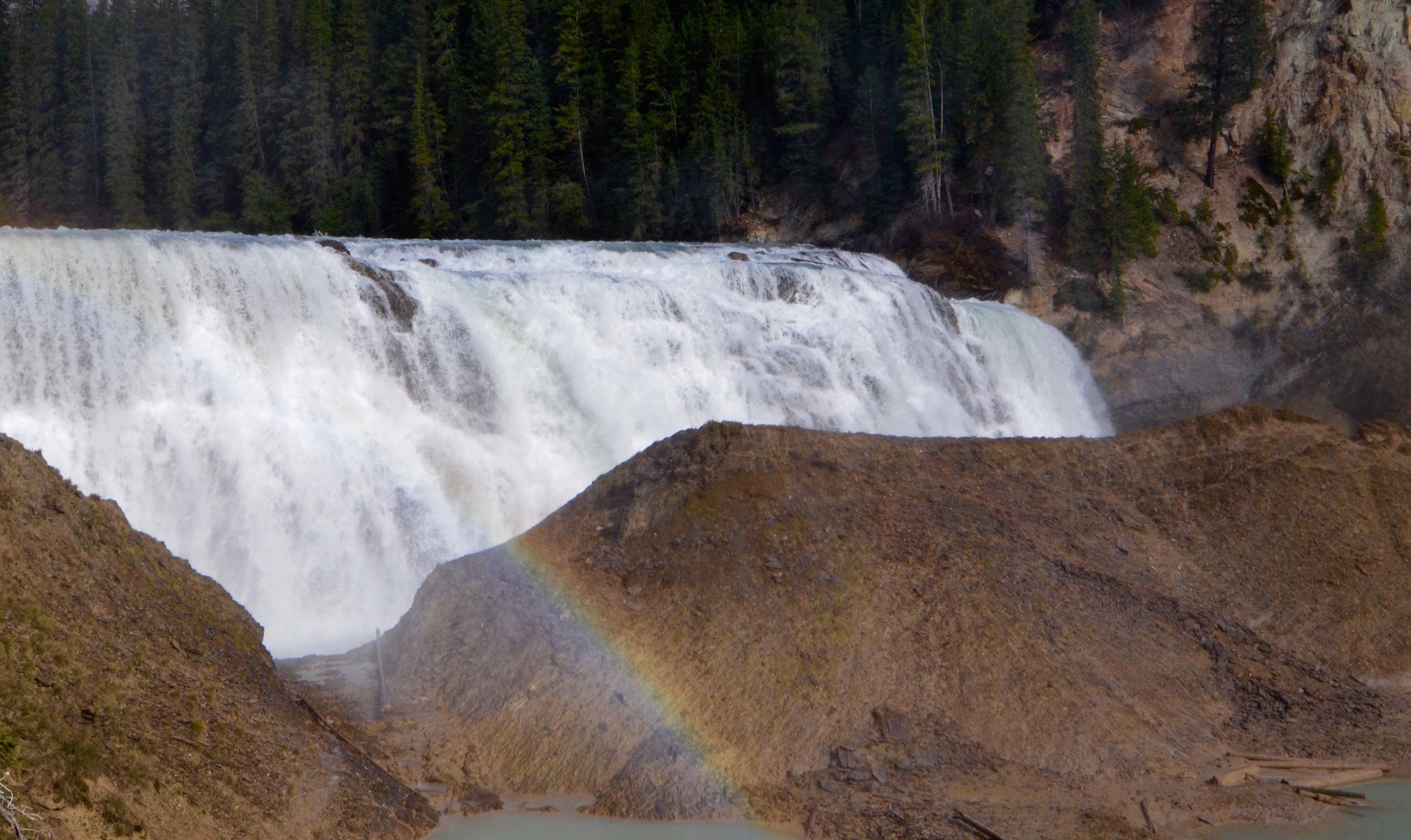
That concludes this post on one of Canada’s greatest national parks. Come see it for yourself and be prepared to “Yoho!” Next we’ll trek to see the Burgess Shales fossils in Kootenay National Park. Hope to see you there.

